Background:
Last week I made a post about some extravagant product claims that prompted a discussion about the relative merits of a FMIC vs. a SMIC (stock mount IC).
A couple of days after that my attention was brought to a specific example of a comparison of a FMIC and SMIC, a discussion about how the do88 stock location IC compares with the ARM front mount IC.

Seeing how I have operating data on each of these intercoolers from using them on my GTI, I decided to compare my results with the claims made by participants of the discussion.
Claims:
The first claim is that the stock location do88 is double the size of the ARM front mount, and therefore you should get a stock location IC.
Then Matt At EQT claims to have been part of a failed tuning session, without defining what that is, and that it was caused by a pressure drop produced by the ARM FMIC. The stock GTI IC was reinstalled and the car made more boost with “15% less gate”. Presumably “gate” refers to the wastegate duty cycle.
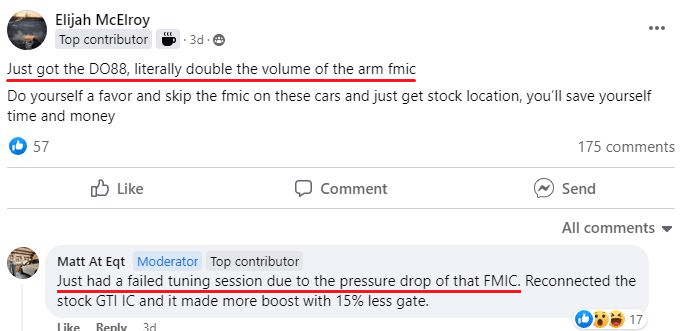
Fact 1 – do88 is “literally double the volume of the arm fmic“.
The ARM FMIC core dimensions are 22″ x 9″ x 3.25″, for an enclosed volume of 643.5 cubic inches.
The do88 IC core dimensions are 24.96″ x 16.69″ x 2.24″, for an enclosed volume of 933.1 cubic inches.
The do88 core volume is 45% greater than the ARM core volume.
Doubling the volume would be a 100% difference. 45% is well short of double the volume.
Conclusion: False
Note: An alternative method for measuring the core volume is to fill each intercooler with water, measure the volume of water contained within the IC, and then subtract the volume of water in the end tanks. This is a more involved process and there was no indication the person commenting used this method to arrive at their conclusion.
Fact 2 – Changing from ARM to stock GTI IC produces a 15% drop in the wastegate duty cycle (wgdc).
This statement omits important information about the size of the turbocharger that was involved. If the turbocharger size is larger the mass flow rate can increase from higher operating pressure. The volumetric flow rate can also increase since the maximum operating engine speed can increase without reducing operating pressure. Increasing one, or both, of these factors will increase the pressure drop across the intercooler core.
This is an important consideration because the manufacturer of the ARM FMIC advises using bicooler hoses if using the intercooler with a larger, “hybrid”, turbocharger.

An assessment of the effect of the IC pressure drop will be made using data I have from my GTI when operating with an IS38 turbocharger on a custom ECU tune.
Before getting to that, an additional set of Facts to check will be added, since the data analysis lends itself to evaluating multiple operating variables.
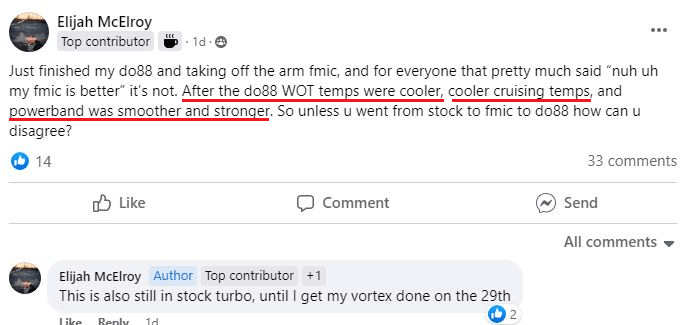
Fact 3 – Changing from ARM IC to do88 IC produced cooler WOT temps.
Fact 4 – Changing from ARM IC to do88 IC produced cooler cruising temps.
Fact 5 – Changing from ARM IC to do88 IC produced a stronger powerband.
Fact 6 – Changing from ARM IC to do88 IC produced a smoother powerband.
Addressing a few of these “Facts” out of order.
Fact 4 – Changing from ARM IC to do88 IC produced cooler cruising temps.
I’ve addressed the subject of cruising temperatures a few times (IAT Sensor Lies) illustrating that the IAT sensor is very unreliable at lower airflow rates, such as occur when cruising. Trying to assess IC performance using this unreliable measure is unproductive.
In addition to the sensor being unreliable, the temperature while cruising is relatively unimportant since the engine produces a small percentage of the maximum potential power under this condition.
As a logic exercise, this claim does not add up. The ARM FMIC should cool better when cruising. The ARM FMIC is located in front of the AC condenser and is the first heat exchanger that outside air passes through, which should provide it with the coolest air available. The stock location intercooler is located behind the AC condenser and in front of the radiator. This could decrease the pressure differential across the cooling fins, which would decrease the rate of cooling air passing through the fins. Also, the location in front of the radiator would expose the IC to radiant heat transfer and potentially convective heat transfer.
I often use an additional temperature sensor in the cold side charge pipe to get an accurate measure of the air temperature exiting from the intercooler (IC_Out). Since it isn’t a very important measure I’ve not done a thorough analysis of how this variable compares between intercoolers, but shown below are a couple of examples that suggest the differences in these intercoolers are minimal.
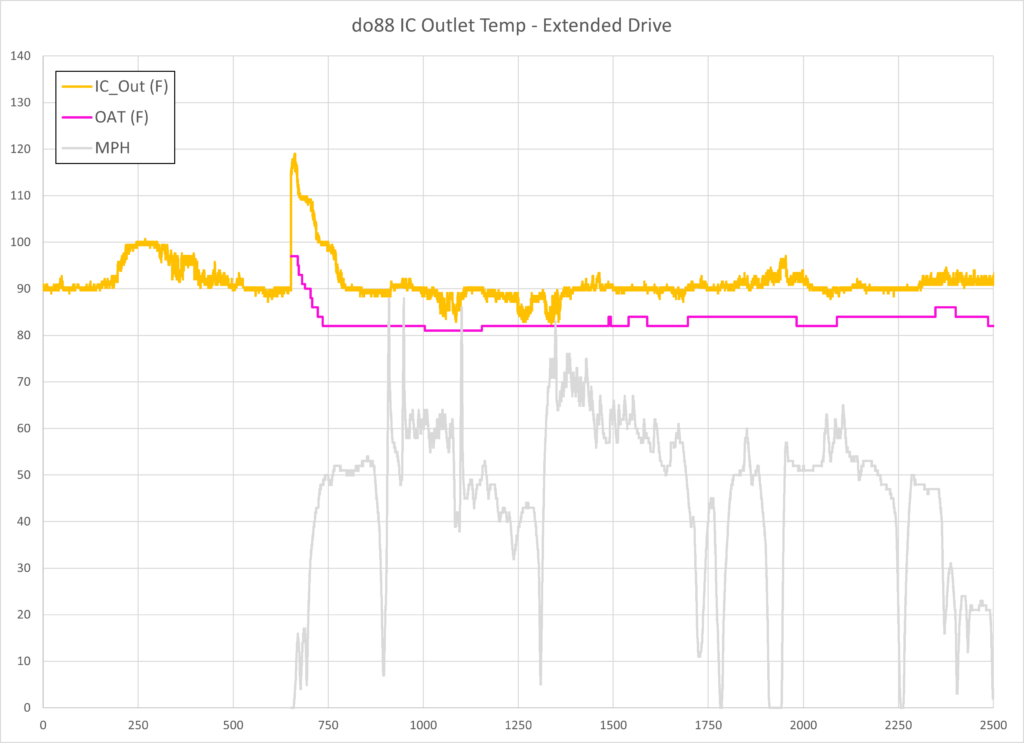
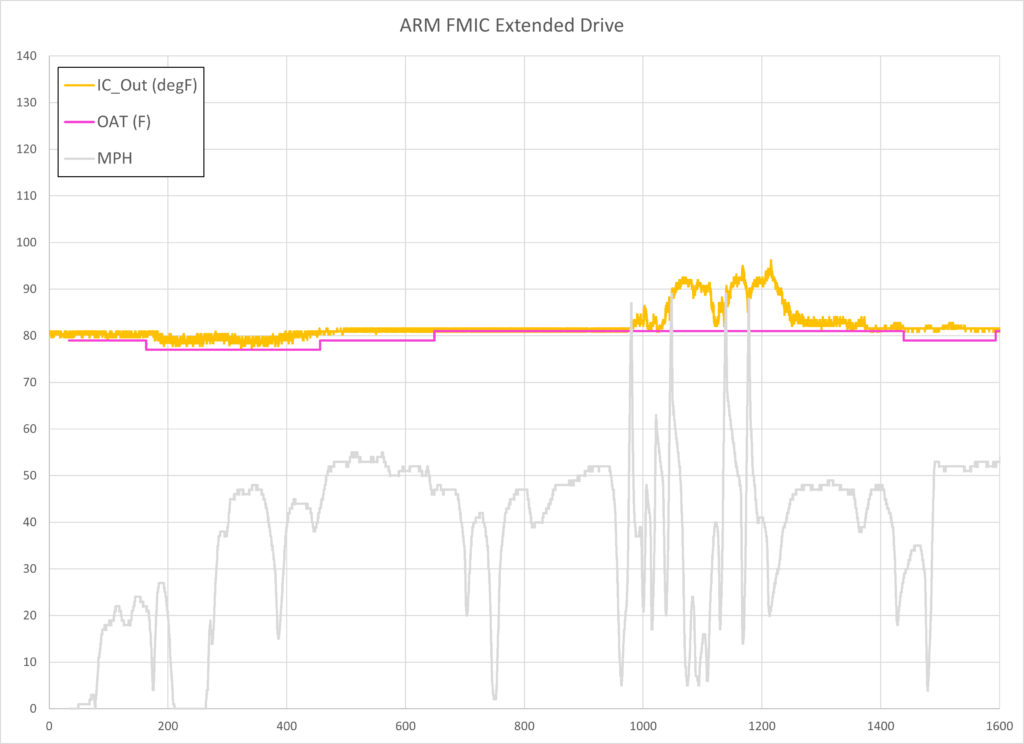
Conclusion: False
Fact 5 – Changing from ARM IC to do88 IC produced a stronger powerband.
No dyno chart comparing powerbands was presented. Presumably, this is a subjective “butt-dyno” assessment and therefore an unverifiable belief of the commenter.
I do not have a dyno chart comparing powerbands with each intercooler to refute or confirm this claim.
Conclusion: Inconclusive due to insufficient information.
Fact 6 – Changing from ARM IC to do88 IC produced a smoother powerband.
Same as Fact 5. Subjective belief.
Conclusion: Inconclusive due to insufficient information.
Meat & Potatoes time:

With the irrelevant claims out of the way, now for a look at how the two claims that matter stack up versus evidence:
Fact 2 – Changing from ARM to stock GTI IC produces a 15% drop in the wastegate duty cycle (wgdc).
Fact 3 – Changing from ARM IC to do88 IC produced cooler WOT temps.
For this analysis, as previously indicated the data is generated on a Mk7 GTI equipped with an IS38 turbocharger using a custom ECU tune. Both the do88 stock location intercooler and ARM front mount intercooler were installed on the GTI and temperature and pressure readings were recorded.
Note that the pressure drop effects analysis is being made between the ARM IC and do88, not the ARM IC and stock GTI IC as the “failed” EQT tune vehicle was equipped with. Because the do88 IC has a lower pressure drop than the stock GTI IC, the change in the wastegate duty cycle should be equal to, or greater than, the ARM and do88 ICs.
Data of interest is logged during full-throttle (WOT) pulls in third gear beginning around 2,500 RPM and concluding around 6,300 RPM. The intake air temperature (IAT) above the outside air temperature (OAT) will be calculated at 6,000 RPM. The pressure drop between the turbocharger and intake manifold will also be calculated at this engine speed.
Three samples for each intercooler will be shown on most of the charts. Additional samples were used to calculate average values.
The boost curves for each configuration are shown in the chart below:

Fact 3 – Changing from ARM IC to do88 IC produced cooler WOT temps.
Intake air temperature trends for each intercooler during these three sample pulls are shown along with the outside air temperature in the chart below:
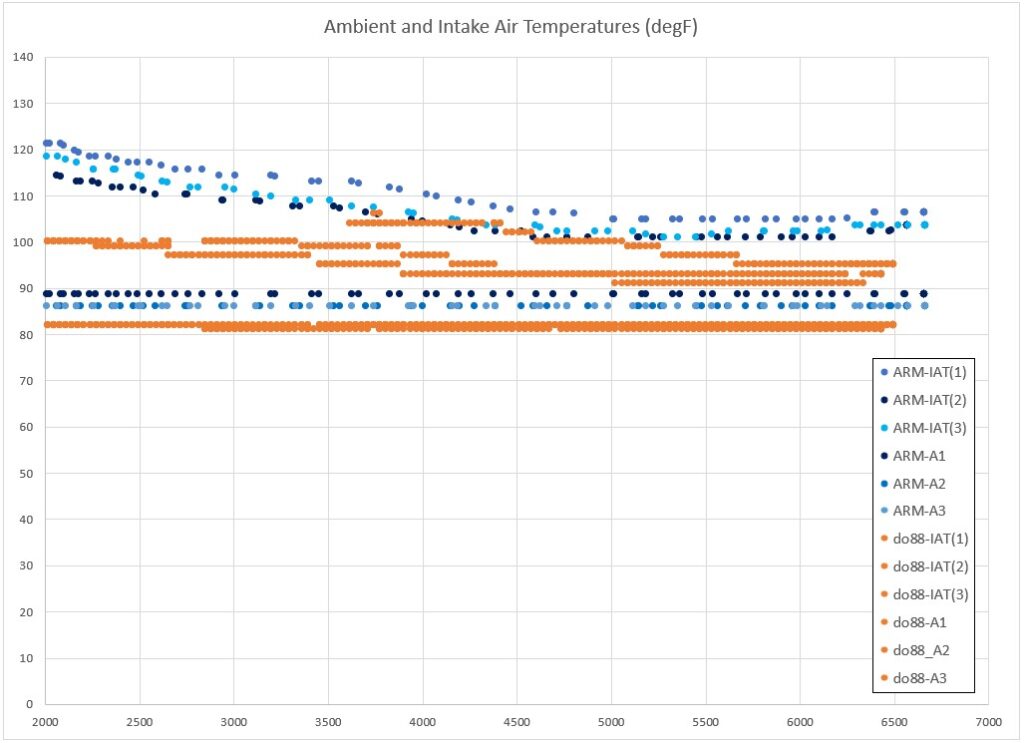
Note that the outside air temperature was 6-8 degrees Fahrenheit less during the do88 data collection. If the outside air temperature curves were normalized the differences between the IAT curves would decrease.
The temperature “delta”, IAT above OAT, for all of the samples is shown on the box plots:

These readings are summarized in the following table:

Note that the mean temperature difference between the intercoolers over 11 and 13 pulls is 0.5 degF.
The descriptive statistics with a confidence interval for the means are shown on the next chart:

Quality check:
Checking the confidence of these measures is done with a t-Test.

With a hypothesis that there is no significant difference in the sample means, at a significance level of 0.05, the p-value is much larger than 0.05. This indicates that there is not sufficient evidence to say that the mean temperature delta is different from zero.
A power analysis shows that at a significance level of 0.05 and a statistical power level of 0.8, sufficient data samples were recorded to detect the effect size observed.

Conclusion – False. Evidence recorded with an IS38 turbocharger does not support a conclusion that the do88 intercooler produces lower intake air temperature during wide-open throttle than the ARM FMIC. It is more unlikely for this to be the case on an IS20-equipped car as the recent post on turbocharger outlet air temperature versus boost shows.
Fact 2 – Changing from ARM to stock GTI IC produces a 15% drop in the wastegate duty cycle (wgdc).
Previously flow testing was conducted on the ARM FMIC, stock GTI IC, and do88 IC. Results are shown in the chart:

The do88 intercooler has a noticeably higher flow rate compared to the other two intercoolers. The percentage gain is shown in the table:

Pressure drop on the operating vehicle is compared in the next chart:

The relative performance of these intercoolers is equal to that during flow bench testing.
The next chart shows the correlation of flow bench measures with operating pressure drop:

All evidence concerning flow rate and pressure drop indicates that the do88 intercooler has less pressure drop across the intercooler than the stock GTI IC.
This being the case, the change in wastegate duty cycle on the operating vehicle, when switching between the ARM FMIC and do88 SMIC should be at least as large, if not greater, than the reported 15% change between an ARM FMIC and stock GTI IC.
On the chart below a green reference line is added to show the projected 15% decrease in WGDC from the ARM FMIC curves.

The change in WGDC from the ARM FMIC (Blue dots) to the do88 IC (Orange dots) does not meet the 15% decrease line.
Conclusion – False. – It is worth noting again that Matt At EQT failed to provide information about the size of the turbocharger involved, why the manufacturer’s recommendation for using the bicooler hose was not followed – if it was a larger turbo, along with other conditions that could have affected the outcome.
Conclusions:
Summarizing the claims analysis that was made about switching from the ARM FMIC to a SMIC.
- Fact 1 – do88 is “literally double the volume of the arm fmic“. Conclusion – FALSE
- Fact 2 – Changing from ARM to stock GTI IC produces a 15% drop in the wastegate duty cycle (wgdc). Conclusion – FALSE
- Fact 3 – Changing from ARM IC to do88 IC produced cooler WOT temps. Conclusion – FALSE
- Fact 4 – Changing from ARM IC to do88 IC produced cooler cruising temps. Conclusion – FALSE
- Fact 5 – Changing from ARM IC to do88 IC produced a stronger powerband. Conclusion: Inconclusive due to insufficient information.
- Fact 6 – Changing from ARM IC to do88 IC produced a smoother powerband. Conclusion: Inconclusive due to insufficient information.
The parties making claims about the benefits of replacing an ARM FMIC with a stock location IC failed to present any proof in support of their conclusions.
Evidence presented in this post refutes these claims for a Mk7 GTI operating with an IS38 turbocharger as described above.

“Note: I have read unfortunate comments made by some people that measuring pressure loss through a part with a flow bench does not correlate with “real-world” pressure losses. These people are woefully uninformed.”
What did you expect bro? The GTI community has been dupped in believing stock location upgrades are better than fmic’s
There’s a shopdap video where the dude with glasses says as much. Then there’s eqt, who can’t go a week without being caught in 5 different lies. Then there’s the other vendors who are full of shit too.
Long ago I was at this subaru get together and I legit told them “the GTI guys really think location doesn’t matter and stock location upgrades perform better than fmic’s.” I had to Google it and prove it because I was told “ain’t no way a community of folks are that dumb”
I’ll say this. Let’s assume they perform the same. The fmic is cheaper, easier to install, and (allegedly) performs the same as a 900+ cubic inch stock location upgrade. How is the stock location considered better? I don’t see an advantage.
It baffles and almost frustrates me how the community is convinced location of the intercooler doesn’t matter. How can someone view a monstrous 900 cubic inch intercooler that still sits between the radiator and ac condenser as a good idea for a small is20, is38, vortex, dtr etc etc. That is insane to me considering I know how much power a rx7 and mk4 supra can make with that size as a fmic. It’s a big freaking intercooler. And that’s what’s needed to offset the stock location’s negatives? But why work around that when u can eliminate that all together and just go fmic?!?
At the end of the day. Any intercooler is better than stock. No doubt. But holy @#$% the GTI community is gullible as #$%@. And i dont mean everyone is but the ones that like regurgitating and repeating bullshit and vendor’s lies sure as hell have the loudest voices.
Absolutely @#$%$* mind blowing.
I think for the average user the differences in how they perform will be transparent.
I agree that overlooking the benefits the front placement has is a mistake.